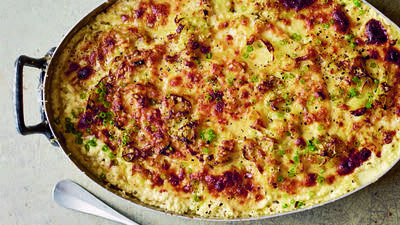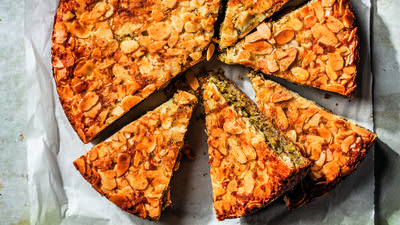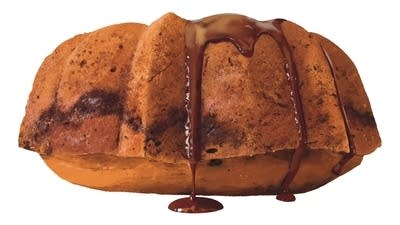
Schmaltz can be made with any amount of skin and fat. The butcher or farmer you buy your chicken from will often save skin and fat for you on request. If you like to make chicken soup, save all the skin and fat before you put the bird in the pot. If you roast a chicken regularly, you can pull loose fat from it and trim unused skin, saving it in the freezer until you have enough to render for schmaltz.
Or, as I suggest here, you can use the skin from packaged chicken thighs, which are widely available, reserving the skinless thighs for other uses.
Chop the skin and fat well. This is easiest if it's frozen or partially frozen. The fi ner you chop the skin, the more effi ciently it will render. The skin—connective tissue composed mainly of protein—will eventually become gribenes (cracklings), marvelously flavorful browned bits of crispy skin interspersed with caramelized onion, that serve as a fabulous garnish on anything from tossed salad to chopped liver to matzo balls.
Put the skin and fat in a medium saucepan (nonstick, if you have one) with the water and bring to a simmer over high heat. Turn the burner to low and allow the fat to render. This will take anywhere from 90 minutes to several hours, depending on how much skin and fat you have and how hot your burner is. Give the skin a stir now and then so that it doesn't stick to the bottom and burn. Keep an eye on it. You don't want to let the fat get too hot and turn brown, which will happen once the water has cooked out of the skin. One of the keys to superlative schmaltz is avoiding a roasted fl avor and an overly browned appearance; you want a light, clear, clean schmaltz.
When the chicken skin is golden brown, add the onion. Continue to cook until the skin and onion are well browned. The gribenes should be crispy-chewy.
Pour the finished schmaltz fat through a fi ne-mesh strainer; if you want very clear fat, line the strainer with cheesecloth or a reusable All-Strain Cloth. Store the gribenes (the onion and cracklings) in a paper towel–lined bowl, covered. Allow the schmaltz to cool, then transfer it to a container, cover, and refrigerate.
Schmaltz will keep for about a week in the fridge, but the sweet, chickeny-oniony fragrance is volatile and will diminish if forgotten behind the week's leftovers. I recommend freezing any schmaltz you won't be using in a day or two. It's best kept in a container, with plastic wrap pressed down onto the surface, covered with a lid or a second layer of plastic wrap, then wrapped in foil if you intend to store for a long time; this careful wrapping prevents other freezer flavors from infiltrating your schmaltz, and the foil will prevent light from damaging the fat over time. Lois recommends freezing schmaltz in 1 1/2-cup/320-milliliter mason jars with rubber seals.
STRATEGIES FOR OBTAINING SCHMALTZ
Many cities have kosher butchers. Kosher butchers often sell schmaltz. They also often reserve chicken skin and fat that can be purchased for rendering. If you buy schmaltz, you can improve the flavor by cooking more skin and onion in it, till everything is browned; this will result in better schmaltz and valuable gribenes.
In Cleveland we have plentiful farmers' markets where farm-raised chickens and eggs are sold. If your city does, too, ask the farmer to reserve skin and fat for you. They often remove it anyway and are happy to accommodate special orders. This is also the best means of fi nding fresh chicken livers, which are essential to excellent chopped liver.
Make roast chicken once a week. Before you roast it, pull off all the fat you see and trim all the skin you won't need, including the back skin. Store the fat and skin in the freezer, and in a month or two, you'll have plenty to render for schmaltz. Be sure to reserve the liquid fat left in the pan after roasting your chicken to make the Pâté de Foie Gras en Terrine or the Roasted Potatoes with Onion and Rosemary.
Make chicken soup using a whole chicken, removing the skin and visible fat from the chicken before adding the chicken to the pot.
You can make plain schmaltz, but since the onion flavor is so wonderful and so easy to include, why bother?
In my peregrinations, I've heard of only one variation on onion-accented schmaltz. A woman in Chicago said that her family always used garlic and paprika in theirs. That certainly sounds to me like a fi ne way to flavor it.
You can do all kinds of things to schmaltz to spice it up -- for instance, cooking dried chiles in it or adding star anise or Chinese five-spice powder -- but we're sticking to the basics here: traditional rendered chicken fat with onion.
Ingredients
Skin and fat from 8 chicken thighs (or 2 cups/450 grams miscellaneous reserved chicken skin and fat)
1/4 cup/60 milliliters water
1 spanish onion, cut into medium dice
Yield: 1/2 cup/120 grams schmaltz and 1/2 cup/60 grams gribenes
 1. Cook the chopped chicken fat and skin in a small amount of water to begin the rendering at a gentle temperature.
1. Cook the chopped chicken fat and skin in a small amount of water to begin the rendering at a gentle temperature.
 2. Once the water and the moisture in the fat and skin have cooked off, the fat can rise above 212°F/100°C and the browning can begin.
2. Once the water and the moisture in the fat and skin have cooked off, the fat can rise above 212°F/100°C and the browning can begin.
 3. When the skin is lightly browned and plenty of fat has been rendered, add the chopped onion.
3. When the skin is lightly browned and plenty of fat has been rendered, add the chopped onion.
 4. Be careful not to overcook the fat. It should remain clear and yellow, not brown with an overly roasted flavor.
4. Be careful not to overcook the fat. It should remain clear and yellow, not brown with an overly roasted flavor.
 5. The browned skin and onion, called gribenes, are a delicious by-product of making schmaltz.
5. The browned skin and onion, called gribenes, are a delicious by-product of making schmaltz.
 6. Strain the fat and reserve the gribenes. The schmaltz is ready to use, to refrigerate for up to a week, or to freeze. The gribenes should also be refrigerated or frozen.
6. Strain the fat and reserve the gribenes. The schmaltz is ready to use, to refrigerate for up to a week, or to freeze. The gribenes should also be refrigerated or frozen.
Before you go...
Each week, The Splendid Table brings you stories that expand your world view, inspire you to try something new, and show how food connects us all. We rely on your generous support. For as little as $5 a month, you can have a lasting impact on The Splendid Table. And, when you donate, you’ll join a community of like-minded individuals who love good food, good conversation, and kitchen companionship. Show your love for The Splendid Table with a gift today.
Thank you for your support.
Donate today for as little as $5.00 a month. Your gift only takes a few minutes and has a lasting impact on The Splendid Table and you'll be welcomed into The Splendid Table Co-op.




